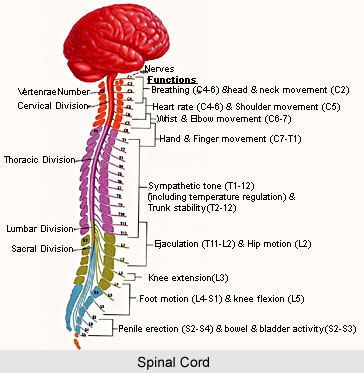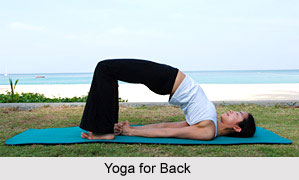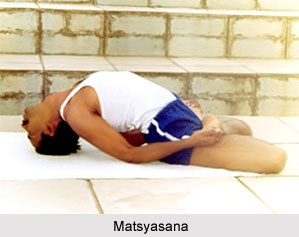 Yoga for Spinal Cord problems are probably the most researched part of Yogic Science. Back pain is the most common reason to seek medical attention and Yoga has consistently been used to cure and prevent back pain by enhancing strength and flexibility. Both acute and long-term stresses lead to muscle tension and exaggerate back problems.
Yoga for Spinal Cord problems are probably the most researched part of Yogic Science. Back pain is the most common reason to seek medical attention and Yoga has consistently been used to cure and prevent back pain by enhancing strength and flexibility. Both acute and long-term stresses lead to muscle tension and exaggerate back problems.
The spinal cord problems arise from tight hamstrings and weak abdominal muscles. The Yoga postures that are practiced can alleviate these conditions over time. However, one should remember that yoga is no short cut method, and results will come slowly and steadily. If the person already has got back-pain, one may enter into yoga poses slowly and eventually gain understanding from each posture practiced.
Common Spinal Cord Problem
Most Spinal Cord problems are not fatal and are musculoskeletal or associated with the Bones, Muscles, tendons, joints, and ligaments. According to studies, majority of Spinal Cord problems is caused by some form of irritation of the nerves that travels from the Spinal Cord through the bones, making the muscles to be stressed.
Herniated Disc is a back injury which can cause acute pain. Symptoms of a Herniated Disc include numbness or tingling sensation in the legs and feet, muscle spasm or cramping, sciatica, loss of leg function, and severe back ache. Smoking, lack of exercise, improper diet, Aging, and poor posture exaggerate the problem. Disc Herniation may progress suddenly or gradually over weeks or months and it ultimately affects the Lumbar Vertebrae. Osteoporosis is a Spinal Cord problem, which can happen without symptoms. Osteoporosis is the disorder wherein the bones become abnormally brittle, less dense which is the result of decreased bone mass or a number of different diseases and abnormalities. Symptoms include fracture in the hips, vertebrae, wrist or other parts of the body, curvature of the spine and loss of height.

Scoliosis is another Spinal Cord problem that shows the abnormal lateral curvature of the spine to the side, either left or right. This ailment is usually developed during childhood and rarely occurs in adults. Common causes include succession of the disease from childhood, asymmetric degeneration of the joint in the spine, or a combination of both. In severe cases, the spine can rotate, resulting in prominent ribs on one side of the body making the spaces between the ribs narrow thus causing complication in Breathing.
Various Types of Yoga for Spinal Cord
Yoga asanas and various types of physical exercises heal the Spinal Cord problems to a great extent. The most common treatment for Spinal Cord problems includes medication, exercise, and a change in lifestyle, sometimes surgery for crucial cases. However, natural method is always Yoga to cure any health disorder. Asanas can further tone the back muscles, make it more flexible, alleviate pain and improve the physical posture. Yoga lifestyle, Yoga poses combined with medical attention is sure to decrease the debilitating effect of Spinal Cord problems.
Savasana
The specific Yoga asanas for Spinal Cord problems brings about stronger and more flexible spine. The Corpse Pose (Savasana) is considered as a classic relaxation pose for back aches and is practiced before or in between Asanas as well as a final relaxation. Savasana is often recommended to be the usual sleeping pose for the person suffering from backache as well. Sleeping on a hard ground, without pillows, serve as a magical treatment to minor back problems. Supine poses like the wind relieving pose or Pavanamuktasana assures the best condition for the digestive system thus indirectly serving the spine problems as well. This asana helps in eliminating excess gas in the stomach. Single Leg Raises is performed in order to prepare the body for other exercises. It benefits the legs, lower back muscles, and abdominal area. Trikonasana provides a great `long stretch` to many of the muscles of the body, stimulates circulation to the spinal area and excites reflex nerve activity, thus benefiting the cranial nerves associated with the sensory organs of the head, especially the eyes.

Matsyasana
The Fish Pose or Matsyasana relieves stiffness of the neck and shoulder muscles and improves flexibility of the spine. It is the counter-pose of the Shoulder stand. The intense pull of the asana helps flexing the hips flexors and muscles between the ribs to make it more functional. This asana helps to stretch most parts of the body.
Bidalasana
Cat Pose or Bidalasana flexes the spine and stretches the middle to upper back and shoulders. It is good exercises for people sit in front of a computer for long hours. This posture efficiently reduces tension from neck and shoulders and alleviates backaches. It also provides massage to the kidneys. However, this Yoga asana should not be practiced in case of recent back injury.
Bakasana
The Crane Pose or Bakasana entails concentration in keeping the balance. This asana helps the upper back by stretching it and making it more flexible for better support. By continuous practice one can achieve that balance. The Cobra Pose or Bhujangasana improves spinal flexibility and strengthens the muscles in the arms and back. The pose of Balasana is a gentle way of stretching the shoulders, hips, thighs, ankles, and back muscles.
Salabhasana
Locust Pose or Salabhasana works primarily on the upper back, the Locust Pose targets the lower part. This posture also strengthens the abdominal area, arms, and legs.
Backbends usually give relief to spinal cord problems like Lordosis. When done purposefully backbends increase the C curve of the lower back.
DISCLAIMER - The Yoga asanas prescribed above should be strictly performed under the supervision of an experienced Yoga teacher.




















